Sponsored by Murakami City
After my visit to the town of Gatsugi, near northern Murakami, I headed to my own special accommodation. I had the opportunity to stay with a family who owns their very own rice farm in one of the best areas for rice production in Japan. I was able to enjoy the atmospheric countryside, and get a taste of the local rice in my meals, as well as the opportunity to plant rice alongside the family. This farm is an ideal destination for green tourism enthusiasts looking for a unique experience in a beautiful natural environment, especially if they are interested in the ecology of rice planting, and the chance to get closer to farmers and the Japanese countryside!
How to Get to the Farmer’s Minshuku by Public Transportion?
From Murakami, access to the small village of Takane, where the Zaigomon accommodation is, is very simple. No need for a car! A bus leaves directly from Murakami, and the family house is only 50 meters away from the bus stop. Just in front of Murakami station, you will see the bus stops. Just take the bus that goes to Takane 高根. It is even marked in romanji “Takane.” Once getting on the bus, you can enjoy the scenery as you gradually leave the city and begin your immersion into the Japanese countryside. The area is pristine, and surrounded by rice fields and mountains, a truly beautiful location. You can check the timetables here. Get off the bus at the terminal stop. In general, it is appreciated if you arrive at a Japanese inn (Ryokan or Minshuku) between 4pm and 6pm as dinner is served fairly early. The bus ride takes about 40 minutes. You will have to pay the driver when you exit the bus. (700Y)

The Minshuku Zaigomon, A Local Experience in the Heart of the Japanese Countryside
In Japan, minshuku (民宿) is equal to what we call a Bed and Breakfast in France or the United Kingdom. It is typically a local house with rooms reserved for tourists and guests. It is a great experience if you come to Japan, as it actually allows you to feel the daily life of a Japanese farmer; it’s an especially great opportunity if you are on budget as it offers a lot for little cost.
I arrived at house Zaigomon around 5:30 pm, I was able to meet the grandmother, the mother, the father and the children. The mother guided me to my room so that I could leave my belongings. The atmosphere was friendly and family orientated, I loved it!



Room
My room had a breathtaking view of the village in Takane. Like all traditional houses, there were tatami mats on the floor. The room had private bathrooms, and a small coffee table with tea and coffee making facilities.

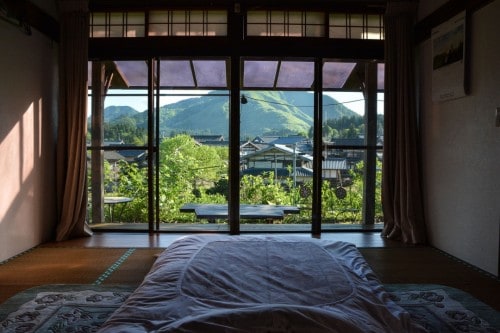
Bathroom
The bathroom was a Japanese traditional style bathroom. Shampoo, conditioner, and body wash were all available for use. When using a Japanese style bathroom, simply sit on the small plastic chair and wash your body and hair thoroughly. Then, after washing, you can soak in the heated bathtub. Natural light shone into the spacious bathroom from this window. It was a real pleasure to try. The house offers towels as well as a hairdryer for guest use.

Dinner
After resting , it was time to sit down for dinner. It was about 7pm when one of little girls told me it was time to head into the main room. Dinner and breakfast were included in the price of lodging, and were served in the dining room. The middle of the dining room had an “irori“, a main fireplace where the family comes to warm themselves by the fire. We sat down and had dinner together surrounding the irori.

I had dinner with the grandmother and a girl from the village who had come to help me translate some conversations into Japanese. It was the grandmother who prepared the traditional Japanese dinner we ate together, which included seasonal items such as “sansai,” wild mountain vegetables which had been picked by her that morning. The meal consisted of miso soup, rice, tempura, “udo” mixed with tofu, “kogomi,” which were dumplings made of mountain vegetables, and warabi flavored with wasabi, a pumpkin salad, shiraae with carrot, tofu, and shitake. Everything was incredibly delicious and seasonal. They even offered me a kind of thick yogurt produced by the family, which was a pure delight! The whole meal accompanied by either a very good sake produced in this region, beer or tea.
Breakfast
The breakfast was served early, around 7:00, because directly after breakfast everyone (including me) had to go to the rice fields. Before going to the dining room, I took the opportunity to have tea on the terrace while admiring the view.
The breakfast was a traditional Japanese meal, all the ingredients were healthy and prepared me for a day of work on the rice fields.
At 8:00am, it was time to head to work. We all headed diligently towards the rice paddies.
How to Book this Minshuku?
To make a reservation, or if you have any questions, you can either emailyumehana.725@zaigomon.com (available in English.) If any inquiry about Murakami, you can consult with Murakami city tourism association.
Murakami City Tourism Association
Address: 11-8 Tabatamachi Murakami-shi, Niigata 958-0854
TEL: 0254-53-2347
Fax: 0254-75-5950
Mail:murakami@sake3.com
If you are interested in experiencing the rice plantation, reservations are available from spring to autumn!
Price: ¥ 1500
Duration: 1-2 hours, usually in the morning.
They also offer other experiences such as, making homemade soba using local buckwheat flour.
Accommodation costs: 8000Y per person including dinner and breakfast. For two people, the price is 7000Y per person. For three people: 6500Y per person. For four people: 5000Y person. The family does not speak English very well, but this will not be a problem at all, during your stay you will feel welcomed and well taken care of regardless of language barriers. Gestures, body language, and a warm smile are enough to communicate with this lovely family.
Takane village
If you have more time, why not stroll around the alleys in Takane village. I especially recommend visiting before sunset, as the fading light lends an especially charming atmosphere to the village.
Plant Rice with a Japanese Family
At 8am in the morning, we went to the rice fields by truck, the fields were only 10 minutes east of the house. The first step was to go into the greenhouse where sets of rice grass were waiting to be loaded onto truck. We carefully packed them onto the truck for transportation.

After 5 minutes of loading rice shoots, we headed to the fields.
With the truck loaded, it was time to take the truck to the family’s rice fields, where we started placing the rice shoots into the rice planation machine. Once filled, we simply added the organic products that were to accompany the crop.


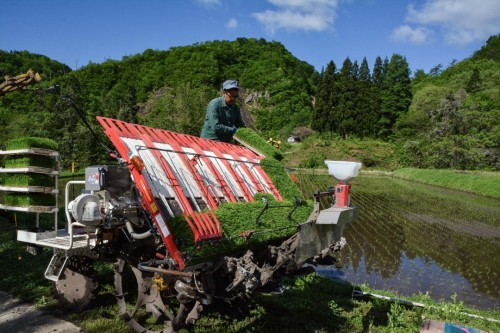


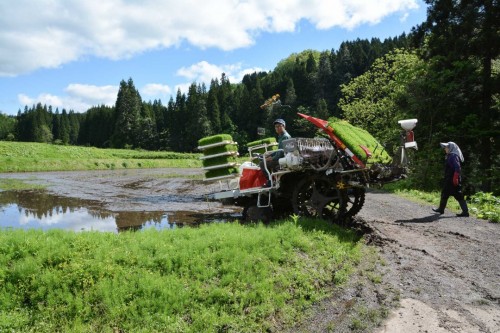
The idea is to position yourself well and organize your field to make straight lines! The mechanical use of the machine is more efficient and quicker. Sometimes rice is also manually planted by the farmers.
I had the chance to drive the truck, but it was difficult to stay straight as you can see in the photo below!

Planting Rice, A Special Experience From Spring to Autumn
If you want to try this incredible experience too, be aware that you can only do it from May to mid October.
Plant rice: around mid-May
Harvest rice: from the end of September to the middle of October
Working in rice fields: in summer
Original article by : Estelle
Translated by: Aika Ikeda










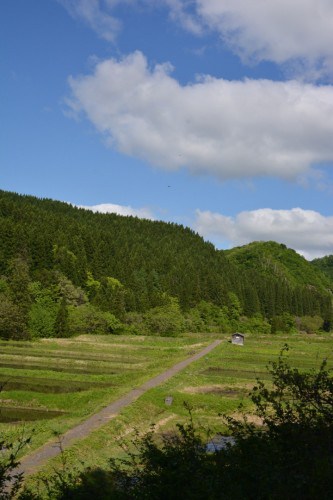











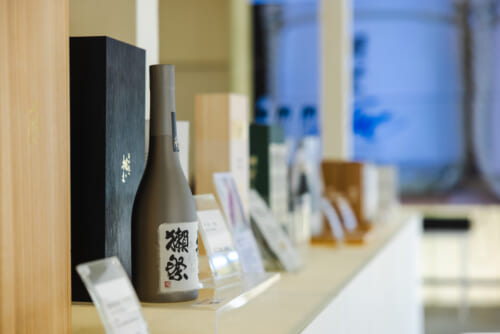




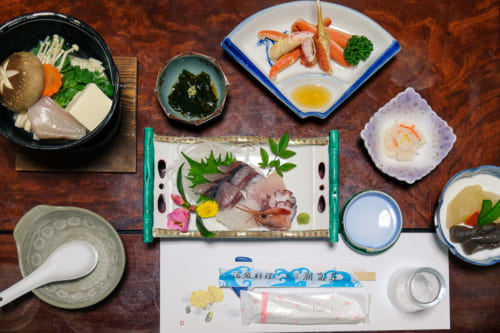
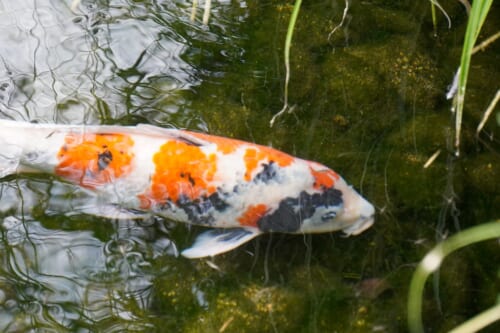


No Comments yet!